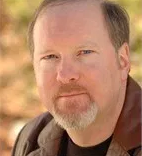Escaping Into Science Fiction
I grew up in a small town in Wisconsin in the US, a rural area with farms, big red barns and tall grain silos . . . and nothing interesting to do. Even as a little kid I was enamored with watching science fiction movies (the Saturday afternoon Sci-Fi Cinema that broadcast old black-and-white science fiction movies with silly special effects and rubber bug-eyed monsters that didn’t look at all silly to me at my wide-eyed age). At the age of five, I remember seeing the George Pal version of The War of the Worlds, and it scared the daylights out of me and had a profound effect, igniting my imagination and making me ponder other worlds, other races (not all of which wanted to invade the Earth).
Our town was too small to have a library of its own, but was serviced by a Bookmobile, a sort of bus/truck combination filled with books that traveled from place to place, making a weekly circuit so that rural communities had access to a steady flow of books. I went to the Bookmobile as often as possible; at my age, I was relegated to the children’s section, which I finished quickly enough, and soon turned my eyes to their shelf or two of science fiction. When I tried to check out an “adult” book, however—Dolphin Island by Arthur C. Clarke—the stern librarian (who looked as if she went to a mortician rather than a beauty parlor) informed me in no uncertain terms that I wasn’t allowed to check out any of the grown-up books because I wasn’t ready for them; apparently, her minimal customer-service abilities had disqualified her from a position in a more stable library (i.e., one not on wheels). I was devastated; this was my only access to new books, and I had set my sights on Asimov, Bradbury, Clarke. Hearing of this, however, my mom—bless her!—marched me right back down to the Bookmobile, checked out the books under her own name, and lectured the mobile-librarian that I was allowed to check out any books I wanted.
Around that time, my parents found an ad in the Sunday newspaper supplement advertising a home library of classics of literature “in handsome paperback format”—one hundred books for the princely sum of $25. The Airmont Classics Library…rather poor-quality paperbacks with cheap paper, inept cover paintings, and microscopic print. It was wonderful! I remember the day the boxes were delivered to our door, and we spent the afternoon unpacking books, looking with delight on title after title, chosen by the staff of the Airmont Library as the greatest works ever written. It was as if treasure chests had fallen from the sky. Jane Austen, Emily Bronte, Charles Dickens…those held no interest for a 9-year-old. But War of the Worlds, The Time Machine, Frankenstein, A Journey to the Center of the Earth, Twenty Thousand Leagues Under the Sea, Dracula, Dr. Jekyll and Mr. Hyde, Master of the World, Treasure Island, Stories of Edgar Allan Poe. It opened the whole world.
For a young man who lived far from any movie theater, with 3-4 television stations available if the antenna on the roof was positioned just right, surrounded by rolling corn and soybean fields and a list of home chores, lawnmowing, garden work…the works of science fiction and fantasy took me away to adventurous and interesting places, exotic worlds. Places far from home.
When I was ten, my mom took me on an expedition to a two-story shopping mall (my first ever) in the big city (of Milwaukee), and we entered a B. Dalton, Bookseller. Though it was nothing like current huge book superstores, it was many times the size of any library I had ever seen, with a whole section devoted solely to science fiction. The bookstore clerk suggested a few authors who might be appropriate, and my mom told me I could pick out two paperbacks and she would buy them. Big mistake. I froze: How could I pick only two? I wanted to read everything there. I went back and forth, picking up one after another, reading the back-cover summary, then trying another one and another one, then going back to an earlier one. My sister, a few years younger, was bored to tears (she wanted to go clothes shopping…talk about boring!) After an hour or so, I finally chose Andre Norton’s Daybreak: 2250 A.D. and H.G. Wells’s Star-Begotten.
Years later, when I was in a creative writing class in college, still in Wisconsin, I submitted science fiction short stories for critique while the other students turned in “creative writing class” stories (plotless things about characters discussing their crumbling relationships over the breakfast table). In exasperation, the professor (who had published a single novel and took it as a point of pride that he was five years late on his next novel deadline) asked me, “Anderson, why don’t you write about anything real? Why not do a story about a young man who grew up in a farming town who’s working his way through college as a waiter in a restaurant?” The suggestion appalled me. “Because I live that every day. Why would I want to write about a dull, regular life when there are so many more interesting stories to tell and places to describe?” I don’t think he understood my answer any more than I understood his question.
That what science fiction has always been to me—not just lighthearted escape fiction, but genuine escape fiction, a way for me to get away from the mundane and to explore the wonders of the galaxy in my imagination, whether or not I lived in a small, humdrum town. By now I have escaped that small town, but I haven’t even come close to the boundaries of what’s possible in science fiction.

